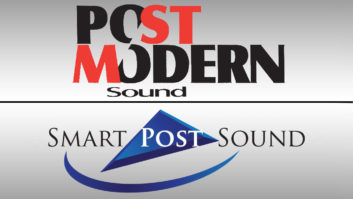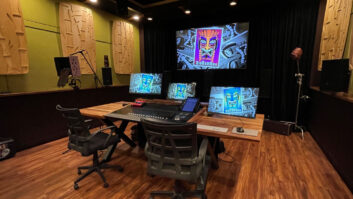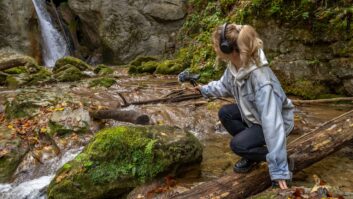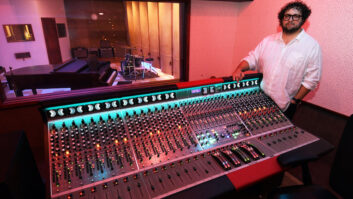Piloting Rocket Sound are (l-r): Tom Hays, founder and general manager; production manager Daniel Khim; and localization and business development manager, Ayumi Logan. N. HOLLYWOOD, CA—On the face of it, a traditional music recording studio might not seem to be the ideal location for an audio post facility, since the two applications have differing needs. But as Tom Hays, founder and general manager of recent start-up Rocket Sound, observes, good acoustic design is fundamental in either environment; the rest is largely cosmetics.

Hays previously built Technicolor Creative’s Game Sound Services in Burbank, CA into a preeminent video game and animation audio facility. Over the years, the sound design team garnered MPSE Golden Reel awards and nominations for titles such as Uncharted 2, Drawn Together, Halo 4, Wolfenstein and Uncharted: Drake’s Fortune. But as Technicolor began to reorganize its global sound services late last year, Hays, along with two of his team members, saw the writing on the wall and left to launch Rocket Sound.
Happily, Hays, production manager Daniel Khim and Ayumi Logan, localization and business development manager, immediately jumped straight into a massive, ongoing project for IO-Interactive. Looking for a permanent base after subletting various facilities, Hays discovered the two-room Entourage Studios complex in the NoHo Arts District. Interestingly, “There were no post places on the market; they were all music studios,” he reports.
“The needs of post and games sound and animation are very different, but I really appreciate the bones of this place,” continues Hays, noting that legendary acoustician Jack Edwards—who had a hand in building Capitol Studios and many other prime L.A. facilities—designed the rooms. It only took a few cosmetic changes to get Studio B ready for game voice recording work, he says: “Things like a good client table and making sure the sight lines are where they need to be.”
Entourage is a classic music facility: Studio A boasts a Harrison 3232 console, two-inch tape machine and racks of analog outboard, while Studio B, where Rocket initially set up shop, features a Trident Series 80 desk and more vintage processing. But it’s the live rooms, which have seen clients from Little Richard to Linkin Park to TV and film scoring dates pass through, that were the big attraction for Rocket Sound.
Studio A, measuring 37-by-25-feet with a high ceiling, has a lot of potential, says Hays. “We can use this as a second single-mic VO room, or we can do ensembles. We can use the booth in B as an iso booth for A, in addition to the two booths in A, so it’s very flexible.”
The larger space also offers potential for recording during motion capture, a process Hays first tried in 2004 while working at game developer Treyarch, and in which his team has become very adept. “People speak differently when they’re moving. If we let these guys perform during motion capture and record the voices, they create these really natural-feeling performances.” Background noise may necessitate line replacement, but, he points out, “They’re skilled actors, and they’re ADR’ing themselves.”
He also notes, “One other unique thing we brought from Technicolor is incorporating localization with original productions.” A game audio house might more typically arrange for translation and foreign language recording after the initial production.
Hays is remodeling the acoustics in B for voice recording; at 23-feetlong, it also provides a decent air volume. “We’re going for neutrality. Not like in a booth, where it sounds super close-up, but in the sense that you can place the sound in different spaces, which in games is really important, because you don’t always know what the environment is going to be. If you have someone out on a grassy field yelling and it sounds like they’re in a room, it takes you out of the game.”
Top-tier games now often outperform movies’ box office, yet the smaller game audio teams can have a bigger workload than film post crews. “A typical triple-A video game has at least 20,000 lines of dialog. That’s 16- or 18-times the amount of dialog in a typical feature. There are thousands of files, and they all need to be right. Someone is going to buy that game and have a long experience with it—20, 40 hours. We’re very cognizant of the fact that someone is going to listen to every line,” says Hays.
“We’re quality geeks; we’re really focused. Not that we’re focused on the high end because that’s where all the money is; we’re focused on the high end because we come from a high end background. It really drives me crazy when people try to cut corners. So we’ve built everything from the ground up to be completely reliable, in terms of assurance of quality. That’s the fun part—making sure we’re doing everything right, having all the right mics, using them correctly, tuning the rooms.” The rest is process, he says.
Hays, who has worked in interactive media for almost 25 years, says, “It’s not a business for the faint of heart right now; it never really has been. The fact that you have to be light on your feet and adapt to change—which a big multinational corporation is not so good at—for me has kept it fascinating.”
Rocket Sound
rocketsound.net







